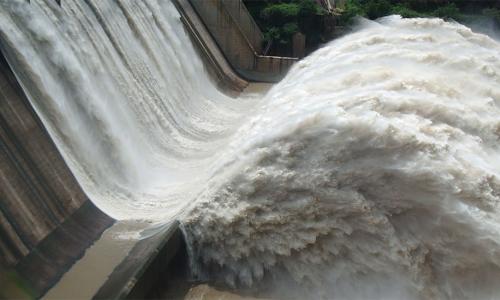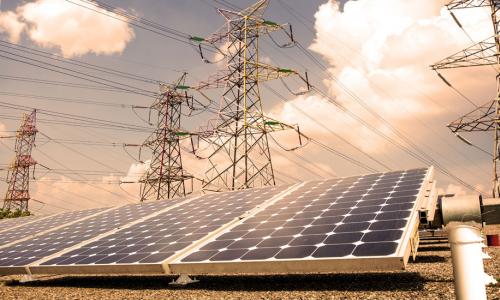Table of Contents
Hydroelectric power includes both massive hydroelectric dams and small run-of-the-river plants. Large-scale hydroelectric dams continue to be built in many parts of the world (including China and Brazil), but it is unlikely that new facilities will be added to the existing U.S. fleet in the future.
Instead, the future of hydroelectric power in the United States will likely involve increased capacity at current dams and new run-of-the-river projects. There are environmental impacts at both types of plants.
Land use
The size of the reservoir created by a hydroelectric project can vary widely, depending largely on the size of the hydroelectric generators and the topography of the land. Hydroelectric plants in flat areas tend to require much more land than those in hilly areas or canyons where deeper reservoirs can hold more volume of water in a smaller space.
At one extreme, the large Balbina hydroelectric plant, which was built in a flat area of Brazil, flooded 2,360 square kilometers—an area the size of Delaware—and it only provides 250 MW of power generating capacity (equal to more than 2,000 acres per MW) [1]. In contrast, a small 10 MW run-of-the-river plant in a hilly location can use as little 2.5 acres (equal to a quarter of an acre per MW) [2].
Flooding land for a hydroelectric reservoir has an extreme environmental impact: it destroys forest, wildlife habitat, agricultural land, and scenic lands. In many instances, such as the Three Gorges Dam in China, entire communities have also had to be relocated to make way for reservoirs [3].
Wildlife impacts
Dammed reservoirs are used for multiple purposes, such as agricultural irrigation, flood control, and recreation, so not all wildlife impacts associated with dams can be directly attributed to hydroelectric power. However, hydroelectric facilities can still have a major impact on aquatic ecosystems. For example, though there are a variety of methods to minimize the impact (including fish ladders and in-take screens), fish and other organisms can be injured and killed by turbine blades.
Apart from direct contact, there can also be wildlife impacts both within the dammed reservoirs and downstream from the facility. Reservoir water is usually more stagnant than normal river water. As a result, the reservoir will have higher than normal amounts of sediments and nutrients, which can cultivate an excess of algae and other aquatic weeds. These weeds can crowd out other river animal and plant-life, and they must be controlled through manual harvesting or by introducing fish that eat these plants [4]. In addition, water is lost through evaporation in dammed reservoirs at a much higher rate than in flowing rivers.
In addition, if too much water is stored behind the reservoir, segments of the river downstream from the reservoir can dry out. Thus, most hydroelectric operators are required to release a minimum amount of water at certain times of year. If not released appropriately, water levels downstream will drop and animal and plant life can be harmed. In addition, reservoir water is typically low in dissolved oxygen and colder than normal river water. When this water is released, it could have negative impacts on downstream plants and animals. To mitigate these impacts, aerating turbines can be installed to increase dissolved oxygen and multi-level water intakes can help ensure that water released from the reservoir comes from all levels of the reservoir, rather than just the bottom (which is the coldest and has the lowest dissolved oxygen).
Life-cycle global warming emissions
Global warming emissions are produced during the installation and dismantling of hydroelectric power plants, but recent research suggests that emissions during a facility’s operation can also be significant. Such emissions vary greatly depending on the size of the reservoir and the nature of the land that was flooded by the reservoir.
Small run-of-the-river plants emit between 0.01 and 0.03 pounds of carbon dioxide equivalent per kilowatt-hour. Life-cycle emissions from large-scale hydroelectric plants built in semi-arid regions are also modest: approximately 0.06 pounds of carbon dioxide equivalent per kilowatt-hour. However, estimates for life-cycle global warming emissions from hydroelectric plants built in tropical areas or temperate peatlands are much higher. After the area is flooded, the vegetation and soil in these areas decomposes and releases both carbon dioxide and methane. The exact amount of emissions depends greatly on site-specific characteristics. However, current estimates suggest that life-cycle emissions can be over 0.5 pounds of carbon dioxide equivalent per kilowatt-hour [5,6].
To put this into context, estimates of life-cycle global warming emissions for natural gas generated electricity are between 0.6 and 2 pounds of carbon dioxide equivalent per kilowatt-hour and estimates for coal-generated electricity are 1.4 and 3.6 pounds of carbon dioxide equivalent per kilowatt-hour [7].
References:
[1] Fearnside, Phillip M. 1989. Brazil's Balbina Dam: Environment versus the legacy of the Pharaohs in Amazonia. Environmental Management, July/Aug 1989, Volume 13, Issue 4, pp 401-423.
[2] National Renewable Energy Laboratory (NREL). 2012. Renewable Electricity Futures Study. Hand, M.M.; Baldwin, S.; DeMeo, E.; Reilly, J.M.; Mai, T.; Arent, D.; Porro, G.; Meshek, M.; Sandor, D. eds. 4 vols. NREL/TP-6A20-52409. Golden, CO: National Renewable Energy Laboratory.
[3] Yardley, Jim. November 19, 2007. Chinese Dam Projects Criticized for Their Human Costs. New York Times.
[4] National Renewable Energy Laboratory (NREL). 2012. Renewable Electricity Futures Study.
[5] IPCC, 2011: IPCC Special Report on Renewable Energy Sources and Climate Change Mitigation. Prepared by Working Group III of the Intergovernmental Panel on Climate Change [O. Edenhofer, R. Pichs-Madruga, Y. Sokona, K. Seyboth, P. Matschoss, S. Kadner, T. Zwickel, P. Eickemeier, G. Hansen, S. Schlömer, C. von Stechow (eds)]. Cambridge University Press, Cambridge, United Kingdom and New York, NY, USA, 1075 pp. (Chapter 5 & 9).
[6] National Academy of Sciences. 2010. Electricity from Renewable Resources: Status, Prospects, and Impediments. Washington, DC: The National Academies Press. Online at http://www.nap.edu/openbook.php?record_id=12619
[7] IPCC, 2011: IPCC Special Report on Renewable Energy Sources and Climate Change Mitigation.





